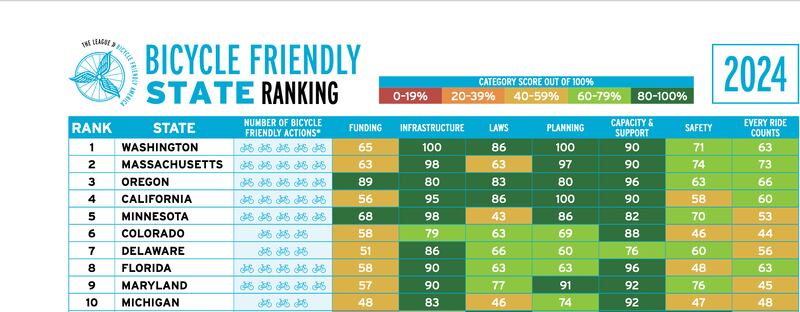The League of American Bicyclists today released its ranking of which states are friendliest to cyclists. That list draws on seven indicators to assign ratings. Of those seven, the group gives the greatest weight to infrastructure, safety and funding.
Oregon is near the top of the rankings nationally, but fell this year to third, one spot down from a second-place rating last time.
Here are the top 10 states:

Last week, the Oregon Department of Transportation announced the state led the nation in participation in “walk and roll to school day,” a reflection of efforts to get more kids and their families out of vehicles and engaged in more active transportation.
But the news in today’s report included sobering information about safety.
“Oregon succeeds when advocates, lawmakers, and decision makers are united in their belief that better bicycling benefits everyone,” said Ken McLeod, policy director of the League of American Bicyclists. “Their ranking this year celebrates the progress they’ve made, but also reflects their increase in bicyclist deaths—a stark reminder that more must be done to protect people who bike.”
The league issues its report every two years. ODOT crash figures show that 12 cyclists died in Oregon in 2022 and 18 died in 2021. Those numbers are why Oregon ranks 15th among all states for safety while ranking first for ridership and “capacity and support.”
In its report, McLeod’s group highlighted an alarming trend in fatalities nationally. “Between 2009 and 2022, there was a 76% increase in bicyclist deaths nationwide,” the report says. In 2022, the last year for which there is data, the number of cyclist deaths reached 1,105.
The Oregon Legislature’s Joint Committee on Transportation traveled the state this summer, trying to drum up support for a large transportation funding package in 2025. Part of that package would comprise safety improvements for pedestrians and cyclists. ODOT’s well-chronicled financial struggles have led the agency to the brink of fiscal disaster and prompted the agency to prepare Oregonians for “a rapid decline in the safety, quality, and reliability of their transportation system,” so how much money there will be for any transportation expenditure is an open question.
In the budget she released in early December, Gov. Tina Kotek signaled she would remain focused primarily on housing, mental health and education. Her proposed transportation budget falls about $1.75 billion short of what ODOT says it needs, putting the onus on lawmakers to find a funding solution for the agency in the 2025 session.
The co-chair of the Joint Transportation Committee, state Rep. Susan McLain (D-Hillsboro), connected funding to the loss of life on Oregon roads. (State data shows that fatal crashes on Oregon highways are significantly higher than pre-pandemic rates.)
“Safety is our No. 1 priority in all modes of multimodal transportation in Oregon,” McLain said today.
Sarah Iannarone, executive director of The Street Trust, a Portland nonprofit that advocates safe, active transportation, called on lawmakers to step up next year.
“Oregon is at a crossroads,” Iannarone said. “This report is a call to action. We need bold investments to maintain our leadership in active transportation and ensure the safety of all road users.”

